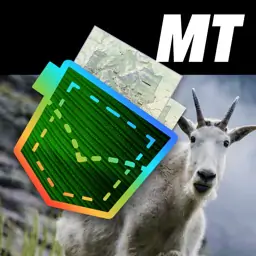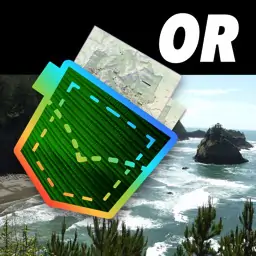"Banks Lake" by NPS/Dubar , public domain
Washington SectionIce Age Floods |
Brochure and Map of the Washington Section of Ice Age Floods National Geologic Trail (NGT) in Washington, Oregon, Idaho and Montana. Published by the Washington State Department of Natural Resources.
featured in
| National Parks Pocket Maps |  | |
| Idaho Pocket Maps |  | |
| Montana Pocket Map |  | |
| Oregon Pocket Maps |  | |
| Washington Pocket Maps |  |
i
l
l
e
r
a
I
e
c
Ginkgo Petrified Forest 7
Ripple marks 9
Lo
be
et
g
u
P
Lewis and Clark
Interpretive Center
ol
C
R
be
S
!
!
!
O c e
a n
Beacon Rock
State Park
!
Columbia Hills
Historical
State Park
Maryhill
State Park
ia
b
um
l
Co
er
Riv
!
a
k
e
Map Symbols
Ice Age Floods National
Geologic Trail, secondary route
Area affected by ice-age floods
Select ice-age floods site
with associated geoheritage values
recreation
ecology
science
& research
Wal l a Wal l a
M O N TA N A
geologic
features
economy
culture
The Floods
Po rtlan d
During the last ice age, between 12 and 17,000 years ago, glaciers covered much of
northern Washington, Idaho, and Montana. The ice was miles thick in places. Portions of the glaciers
repeatedly blocked large river drainages, forming ice dams. Lakes formed behind the ice dams, growing to small
inland seas rivaling the size of the Great Lakes.
The largest of these glacial lakes was Glacial Lake Missoula in what is now
Montana. The lake was approximately 2,500 feet deep in places and extended over
3,000 square miles. It held as much water as about half of Lake Michigan. When the ice
dam burst, all of the water suddenly drained in a matter of days, surging over Idaho, eastern
Washington, and Oregon. The vast amount of water moving over a very short period of time
carved the deeply scoured terrain that forms much of the dramatic landscape we see today.
O R E G O N
In the aftermath of the initial flood, the process of river blockage, ice-dam lake formation, and
catastrophic release occurred repeatedly. Evidence suggests that there could have been as many as 100
separate floods at intervals of about every 50 years.
The features it created are colossal. The water plucked giant columns out of the basalt, created smoothed mesas and
giant potholes, and formed ripple marks between 15 and 30 feet tall. Collectively, this landscape is called the Channeled
Scablands. The floods left behind many other distinctive features, such as, buttes, coulees, and flood bars.
Palouse River Canyon 1
Eugene
Ecology
The ice-age floods left behind prime landscapes for recreation. State
Parks, wildlife refuges, and other protected land ensures continued
availability for public use and wildlife habitat. Visitors can take in the
stunning views while hiking, camping, hunting, fishing, rock climbing, boating,
bird watching, or wildlife viewing.
The shrub steppe ecology found in eastern Washington supports many
types of species only found in this type of environment. Flood-scoured
basalt formations provide unique habitat for wildlife. The Hanford
Reach region on the Columbia River provides habitat for a number of different
species including migratory birds, native mammals, and spawning salmon.
Current research on these landscapes is now being conducted by
NASA. The channeled scablands closely resemble the surface of
Mars, and offer a much closer locality for hands-on study. By
studying the catastrophic effects of the water on the basalt landscape
of Earth, scientists can correlate these to similar features on Mars.
Places to go: Potholes State Park
Places to go: Turnbull National Wildlife Refuge
Places to go: The REACH-Hanford Reach Interpretive Center
Bridgeport State Park
Culture
Economy
The unique landscape left by the floods has been used by
Native Americans for centuries. Historic campsites,
petroglyphs, stone and bone tools, and other relics found along the
paths of the floods, help us to better understand these ancestral
peoples whose descendants still populate the region.
The economy of the channeled scablands and the Pacific
Northwest is supported by features created by the floods.
The voluminous Columbia River discharges an average of 264,900
cubic feet per second. Industry in the dryland regions of eastern
Washington depends on this lifeline for transportation, energy,
agriculture, earth materials, and irrigation.
The terrain left by the floods also influences how present-day
Washingtonians use this region. Cultural exhibits at many of the
selected sites have more information on the lives and livelihoods of
those who call this territory their home.
Places to go: Grand Coulee Dam
Maryhill State Park
Places to go: Columbia Hills Historical State Park
Lewis & Clark Interpretive Center
Fort Spokane Visitor Center
Ginkgo Petrified Forest State Park
Yakima Sportsman State Park
Palouse Falls State Park
Vineyards in eastern
Washington 23
Native Americans fishing at Celilo
Falls (now inundated by Lake Celilo) 21
Petroglyphs at Ginkgo Petrified Forest
State Park 20
Data Sources: Ice Age Floods National Geologic Trail routes adapted from Ice Age Floods National Geologic Trail Long-Range Interpretive Plan Master
Trail Map. Glacial ice and ice-age flood affected areas modified from Silkwood, J.T. (1998), Glacial Lake Missoula and the channeled scabland : a digital
portrait of landforms of the last ice age, Washington, Oregon, northern Idaho, and western Montana, United States Forest Service, Northern Region,
Minerals & Geology, Geology Program Digital Mapping.
Hiking below Dry Falls 13
Bird watching 12
M i ssoul a
P e ndl eton
Recreation
Boating and fishing on
the Yakima River 11
!
Ice Age Floods National
Geologic Trail, primary route
A sto r i a
Historical research of the floods has contributed to our
understanding of catastrophic processes. Ongoing research
has helped us understand the sources of ice-age flood
waters, the effects vast amounts of water had on surface topography,
and the intervals at which these floods occurred.
Sun Lakes–Dry Falls State Park
I D A H O
Tr i C i t i e s
Science & Research
Lincoln Rock State Park
b
a
n
d
s
Palouse Falls
State Park
Cape Disappointment 10
Beacon Rock State Park
l
L
Tu r n b u l l N a t i o n a l
Wi l d l i f e R e f u g e
Lew i s ton
The REACH
Hanford Reach
Interpretive Center
!
Basalt columns 8
c
a
n
l
C oeur d’ Al ene
!
P a c
i f i
c
Seep Lakes 6
Beacon Rock 4
Ginkgo
Petrified Forest
State Park \
Wa n a p u m R e c r e a t i o n a l A r e a
h
n
e
l
e
d
ia
la
White Bluffs Touchet beds 5
Dry Falls 3
!
!
c
u
Palouse Falls 2
Ginkgo Petrified Forest State Park
Ya k i m a
C
a
!
l a
e
d
o
Beacon Rock State Park
Sun Lakes–Dry Falls State Park
W A S H I N G T O N
Ya k i m a
Sportsman
State Park
ob
ea
s
Steamboat Rock State Park
Potholes
State Park
Ellensburg
L
th
s
Geologic features can be seen at sites all along the Ice Age Floods
National Geologic Trail, including: Palouse Falls State Park
We n a t c h e e
!
S pokane
Sun Lakes–
Dry Falls
State Park
!
la
i
Bedrock features: colonnades, arches, entablatures
Erosional landforms: scablands, coulees, cataracts
Depositional landforms: gravel bars, rhythmites, ripple marks
Glacial features: erratics, moraines, kames, eskers, drumlins
Wind deposits: dunes, loess hills
Fossils: petrified wood, mammoth bones
Lincoln Rock
State Park
F
M
•
•
•
•
•
•
ne
stli
coa
ge
ice-a
approximate
The catastrophic force of the flood waters (see“The
Floods” at right) left behind or exposed many different
geologic features which can be seen along the trail. Some
of these features include:
Olympia
Fort Spokane
Vi s i t o r C e n t e r
Steamboat Rock
State Park
Seattle
!
!
G
Grand Coulee Dam
Vi s i t o r C e n t e r
Bridgeport
State Park
Ice Age Floods
National
Geologic Trail
Geologic Features
Lo
no
O
ka
The recently designated Ice Age Floods National Geologic Trail,
which traverses parts of Montana, Idaho, Washington, and Oregon,
is a prime example of our shared geoheritage. Sites along the Ice Age
Floods trail highlight multiple geoheritage values and offer an
excellent opportunity to connect the public to the natural environment.
In 2009, Congress established the Ice Age Floods National Geologic Trail,
the first ever national geologic trail. Still in the development stage, the
National Park Service is coordinating the planning and development of the
trail with public and private landowners, local and tribal governments, the
Ice Age Floods Institute, and other interested parties. The trail will consist
of an existing network of highways, roads, and footpaths which will offer
interpretive opportunities to bring the story of the ice-age floods to visitors.
e
h
S
ga
n
“Geoheritage is the collection of natural wonders, landforms,
and resources that have formed over eons and come to this
generation to manage, use, and conserve effectively. Geoheritage
locations are valued for many reasons including: scientific,
economic, ecological, education, cultural, aesthetic, artistic, and
recreational purposes.” – American Geosciences Institute
n
t
e
Pu
rc
el
l
Tr
en
Lo
ch
be
d
bi
a
Lo
be
r
er
o
iv
C
um
“Our
Shared
Geoheritage”
Wildflowers above
Palouse Falls 15
Bull elk 14
Sockeye salmon 17
White pelican at
Hanford Reach 16
Geologists collecting rock samples
above Lake Roosevelt 19
Basalt columns in the Channeled Scablands (left)
compared with basalt columns on Mars (right) 18
Photo credits: 1, 2, 3, 10, 13, 15, 16) Daniel Coe, Washington Division of Geology and Earth Resources; 4, 23) Dave Norman, Washington Division of
Geology and Earth Resources; 5, 6, 7, 9) Washington Geologic Survey Photo Collection; 8, 20) J. Whitmer, Washington Geologic Survey Photo Collection;
11) Washington Department of Fish and Wildlife, http://bit.ly/2e33bpY; 12) George Gentry, U.S. Fish and Wildlife Service; 14) Washington Department of
Fish and Wildlife, http://bit.ly/2dLKlF5; 17) Dave Menke, United States Fish and Wildlife Service National Digital Library; 18) David Weiss, National
Aeronautics and Space Administration/University of Arizona; 19) Michael Polenz, Washington Division of Geology and Earth Resources; 21) Sean Linehan,
National Oceanic and Atmospheric Administration Historic Fisheries Collection; 22) Joe Smillie, Washington State Department of Natural Resources; 24)
United States Bureau of Reclamation, http://on.doi.gov/2dtiVli
Wheat harvest and
wind turbine 22
Grand Coulee Dam 24





